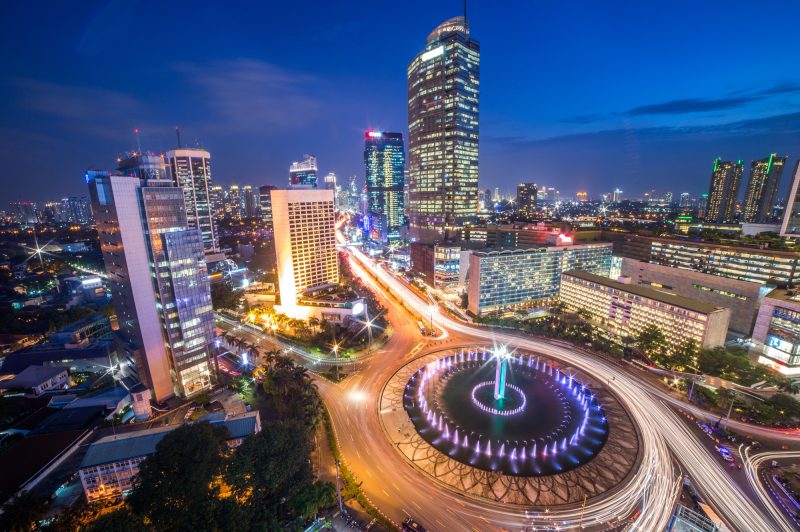Asian capitals are increasingly dominating the ranks of the world’s most populous cities. Tokyo-Yokohama continues to be the largest urban area in the world, a ranking it has held for more than six decades. It is estimated that Tokyo-Yokohama houses a population of 37.9 million, living in approximately 8,500 square kilometres with a population density of 4,400 per square kilometre.
Greater Jakarta is the second largest urban area, with a population of 31.8 million (9,600 per square kilometre). Delhi, India’s capital, held onto third position, with a population of 26.5 million. Delhi has now opened up a more than 3.5 million lead on eighth-ranked Mumbai, which had been India’s largest urban area before, and which some experts had considered likely to become the world’s largest city. (Source: www.newgeography.com)
Greater Jakarta is considered to be a megacity. A megacity is a very large city, typically with a metropolitan population in excess of ten million people. Precise definitions vary: The United Nations Department of Economic and Social Affairs in its 2014 World Urbanization Prospects report counted urban agglomerations having over ten million inhabitants. A megacity can be a single metropolitan area or two or more metropolitan areas that converge – Greater Jakarta is one of these. The terms conurbation, metropolis, and metroplex are also applied to this kind of megacity. The term megacity has also been used to describe metropolitan conurbations containing over 20 million people.
MEGACITY ISSUES AND CHALLENGES
Slums and Homelessness
According to the United Nations, the proportion of urban dwellers living in slums decreased from 47 percent to 37 percent in the developing world between 1990 and 2005. However, due to rising megacity populations, the absolute number of slum dwellers in certain cities may actually be rising. The majority of these come from the fringes of urban margins, located in legal and illegal settlements with insufficient housing and sanitation. This has been caused by massive migration, both internal and transnational, into cities, which has caused growth rates of urban populations and spatial concentrations not seen before in history. Megacities often have significant numbers of homeless people. The actual definition of homelessness varies from country to country, or among different entities or institutions.
Gentrification
Gentrification and urban gentrification denote the socio-cultural changes in an area resulting from wealthier people buying housing property in a less prosperous community. Consequent to gentrification, the average income increases and average family size decreases in the community, which may result in the informal economic eviction of the lower-income residents, because of increased rents, house prices, and property taxes. This type of population change reduces industrial land use, when it is redeveloped for commerce and housing. In addition, new businesses, catering to a more affluent base of consumers, tend to move into formerly blighted areas, further increasing the appeal to more affluent migrants and decreasing the accessibility to less wealthy natives.
Crime
As with any large concentration of people, there is usually crime. High population densities invariably result in higher crime rates, as clearly seen in growing megacities such as Karachi, Mumbai, Cairo, Rio de Janeiro and Lagos. Crime is probably under reported in Jakarta.
Air Pollution
Greater Jakarta urban areas have significant problems with air pollution derived from vehicle emissions and industrial fumes that react in the atmosphere with sunlight to form secondary pollutants. These also combine with the primary emissions to form photochemical smog.
Energy and Material Resources
The sheer size and complexity of megacities like Greater Jakarta give rise to enormous social and environmental challenges. Whether megacities like Greater Jakarta can develop sustainably depends to a large extent on how they obtain, share, and manage their energy and material resources. There are correlations between electricity consumption, heating/cooling and industrial fuel use, ground transportation, energy use, water consumption, waste generation and disposal, and how efficiently these resources are used.
Urban and Suburban Sprawl
Urban sprawl, also known as suburban sprawl, is a multifaceted concept which includes the spreading of a city and its suburbs to its outskirts to low-density, auto-dependent development on semi-rural land, with associated design features that encourage car dependency. As a result, some critics argue that sprawl has certain disadvantages including longer transport distances to work, high car dependence, inadequate facilities and higher per-person infrastructure costs.
Traffic Congestion
As we all know, traffic congestion is the condition of road networks that occurs as car use increases, and is characterised by slower speeds, longer trip times, increased pollution, and increased vehicular queueing. Traffic congestion is increasing in major cities such as Greater Jakarta and delays are becoming more frequent with workers often facing commuting times of two hours in each direction.
Big Infrastructure to Tackle Growing Pains
Jakarta, to put it mildly, is a difficult city to get around. Ride hailing firms like Gojek and Grab complement the Blue Bird and Express taxi services, but traffic congestion remains a serious problem and public transportation options are limited to an insufficient express bus network (Transjakarta), a commuter train line and an extremely old network of city buses. That, however, is set to change in 2019.
Joko Widodo (Jokowi) came to power in 2014 and one of his administration’s promises was to increase investment in infrastructure. This has taken the form of new toll roads, power stations, airports and seaports across the archipelago, but the two most newsworthy projects in Jakarta are the Light Rail Transit (LRT) and Mass Rapid Transit (MRT) networks. Both of these projects are likely to be completed early in 2019 in advance of the next presidential election.
The MRT runs from South Jakarta to the Hotel Indonesia roundabout in the centre of the city passing right through the heart of the CBD. Commercial buildings with direct or convenient access to the MRT are likely to outperform the rest and developers and investors continue to eye development sites with MRT access. Most locations on the route of the MRT are already considered decent places to live and the good location factor is, to an extent, already captured in residential prices even before the addition of the MRT network.
That brings us to the LRT which connects decentralised locations in the south and east of Greater Jakarta to the centre of the city. The LRT is set to reduce travel times from parts of Greater Jakarta to 30 or 40 minutes from one and a half hours or more (depending on traffic). This means that inconvenient locations may become convenient overnight and some local and international developers are already looking to tap into growing demand for these locations.
We are extremely excited about the prospects for the property market on the back of these new infrastructure initiatives.
BY LUKE ROWE (HEAD OF RESIDENTIAL PROJECTS JLL)





